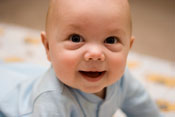Parents and Caregivers
 New Infant Safe Sleep Recommendations
New Infant Safe Sleep Recommendations
CDC supports new recommendations issued by the American Academy of Pediatrics (AAP). These new recommendations aim to reduce the risk of infant death from SIDS as well as death from known sleep-related causes. Read the AAP fact sheet for more information.
Reducing the Risk
Always place babies on their backs to sleep. Babies who sleep on their backs are less likely to die of SIDS than babies who sleep on their stomachs or sides. Placing your baby on his or her back to sleep is the number one way to reduce the risk of SIDS.
Use the back sleep position every time. Babies who usually sleep on their backs but who are then placed on their stomachs, such as a nap, are at very high risk for SIDS. It is important for babies to sleep on their backs every time, for naps and at night.
Place your baby on a firm sleep surface, such as a safety-approved crib mattress covered with a fitted sheet. Never place a baby to sleep on a pillow, quilt, sheepskin, or other soft surface. (See crib safety information from the Consumer Product Safety Commission for more information.)
 Keep soft objects, toys, and loose bedding out of your baby’s sleep area. Don’t use pillows, blankets, quilts, sheepskins, sleep postioner, or pillow-like bumpers in your baby’s sleep area. Keep all items away from the baby’s face.
Keep soft objects, toys, and loose bedding out of your baby’s sleep area. Don’t use pillows, blankets, quilts, sheepskins, sleep postioner, or pillow-like bumpers in your baby’s sleep area. Keep all items away from the baby’s face.
Avoid letting your baby overheat during sleep. Dress your baby in light sleep clothing and keep the room at a temperature that is comfortable for an adult.
What does a safe sleep environment look like?
To learn more about safe sleep environment and reducing the risk of SIDS, check out the National Institute of Child Health Development (NICHD) publication What does a safe sleep environment look like? [PDF - 194KB].
What groups are most at risk for SIDS?
Babies who are placed to sleep on their stomachs or sides are at higher risk for SIDS than babies who are placed on their backs to sleep. African-American babies are more than two times as likely to die of SIDS as Caucasian babies. American-Indian/Alaska Native babies are nearly three times as likely to die of SIDS as Caucasian babies.
 Will my baby develop flat spots on his or her head from back sleeping?
Will my baby develop flat spots on his or her head from back sleeping?
For the most part, flat spots on a baby’s head go away a few months after the baby learns to sit up. There are other ways to reduce the chance that flat spots will develop on your baby’s head, such as providing "tummy time" when your baby is awake and someone is watching. "Tummy time" not only helps prevent flat spots, but it also helps a baby’s head, neck, and shoulder muscles get stronger.
Bereavement
If you or someone you know has experienced the loss of an infant, the following organizations may offer support:
Get email updates
To receive email updates about this page, enter your email address:
Contact Us:
- Centers for Disease Control and Prevention
1600 Clifton Rd
Atlanta, GA 30333 - 800-CDC-INFO
(800-232-4636)
TTY: (888) 232-6348 - New Hours of Operation
8am-8pm ET/Monday-Friday
Closed Holidays - cdcinfo@cdc.gov


